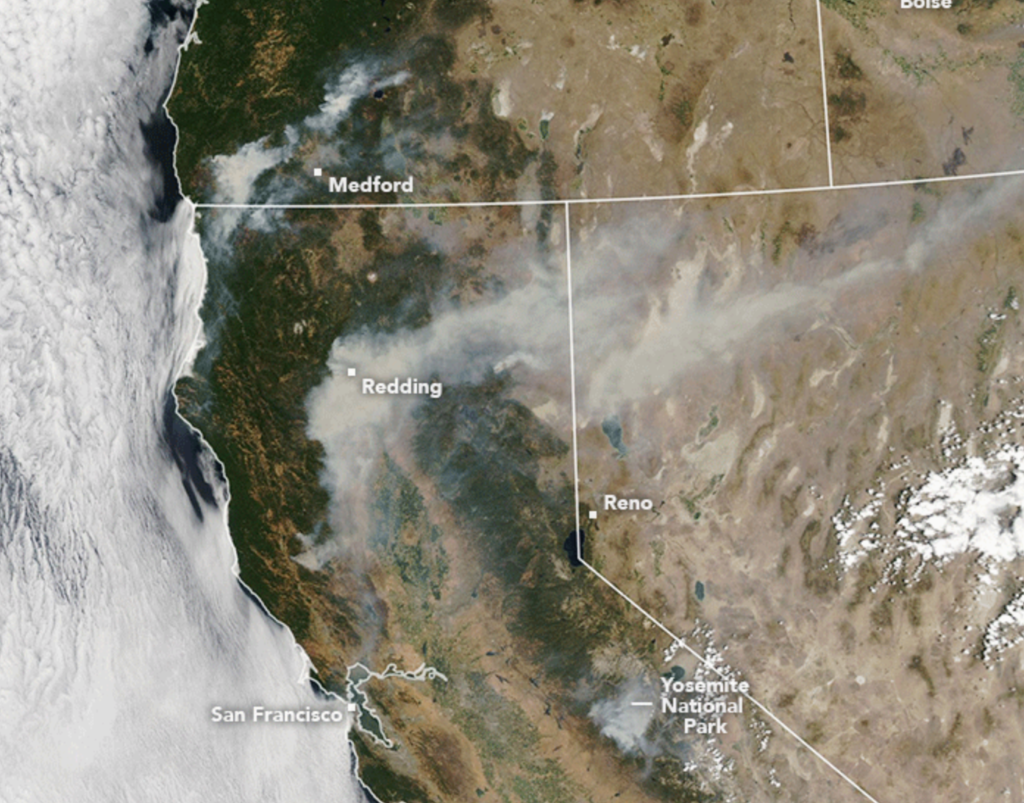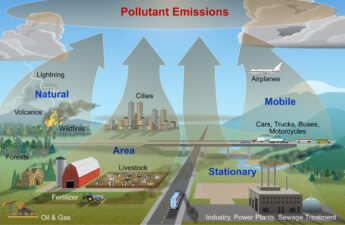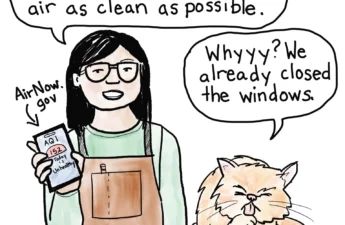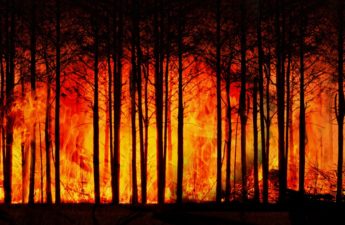
Breathing ‘A Chore’: California Wildfires Threaten The Health Of Young And Old
Debbie Dobrosky noticed a peculiar hue in the sky on Monday — “a very ugly yellow casting” — as she peeked outside. A large cloud of smoke had begun to cover the sun.
By Tuesday, the smoke was so heavy that “even inside my apartment I’ve had to use my inhaler twice this morning, which is not a normal thing,” said Dobrosky, a Riverside County, Calif., resident who lives about 30 miles from a fast-growing fire in the Cleveland National Forest.

“Today I’m stuck inside, there’s no going out,” said Dobrosky, 67, who has chronic obstructive pulmonary disease (COPD), an inflammatory lung condition.
At least 17 large fires are burning across California, destroying hundreds of thousands of acres, sending toxic pollutants into the air and contaminating water supplies. The air quality in certain areas — particularly near the massive Mendocino Complex Fire in the northern part of the state — is among the worst officials have ever seen.
And conditions aren’t expected to improve as new blazes break out and others rage uncontrolled. With temperatures at times reaching into the triple digits, unpredictable winds and desiccated brush that serves as kindling, there’s no end in sight to this year’s fire season.
“We are in a situation now where the wildfire season doesn’t really have its normal beginning or end,” said Lori Kobza, spokeswoman for the Sacramento Metropolitan Air Quality Management District.
The 629,000 acres burned this year comes after massive burns last year in Ventura, Santa Barbara, Napa and Sonoma counties, causing dozens of deaths, according to the California Department of Forestry and Fire Protection.
The Mendocino Complex Fire in Northern California quickly grew to overtake last year’s Thomas Fire as the largest in California history. And Shasta County’s Carr Fire generated a “fire tornado” with winds of 143 mph that ripped through the town of Redding.
Many scientists attribute the more frequent and ferocious fires in the U.S. and around the world, at least in part, to climate change.
Meanwhile, air quality districts around the state have issued warnings to stay indoors — with windows shut and the air conditioner running — and to limit outdoor activities. In many places, kids’ ball games, riding lessons and summer camps have been cancelled.
NASA satellite photos show towers of smoke in California billowing into the atmosphere. Up and down the state, air quality officials have marked huge swaths as red with spots of purple — places where air is unhealthy or very unhealthy to breathe. Smoke and ash can travel dozens or even hundreds of miles.
Children, older people and those with respiratory illnesses such as asthma and COPD are particularly at risk of smoke-related health problems. But otherwise-healthy people also may experience short-term breathing problems, eye irritation and coughing.
Fine particulate matter, which is mostly invisible, can lead to inflammation of the lungs and other organs. For people with cardiac problems, toxic smoke has been associated with an increased risk of heart attacks, strokes and death, said Dr. Michael Schivo, associate professor of medicine at University of California-Davis.
Schivo, who has lived in the Sacramento area most of his life, said he can’t remember the air being as bad as in the past few years. More patients with chronic lung disease are experiencing more uncontrolled symptoms, he said.
Lisa Suennen, 52, who lives in Marin County, about 100 miles from the Mendocino fire, has gone to the doctor three times in recent weeks because of lingering respiratory issues. She said her problem started as a cold, but as the air got worse, she developed bronchitis and her asthma flared up. “My lungs do not feel healthy right now,” she said. “It is just not natural to breathe.”
Air quality experts and physicians said more fires are bound to occur, and people with health issues need to have a plan for the bad air days, such as keeping extra medications on hand. “This isn’t the first fire season California has had and it won’t be the last,” said Patrick Chandler, spokesman for the South Coast Air Quality Management District. “You can’t really tough this out.”
Heavy smoke is visible from Debbie Dobrosky’s apartment in Glen Avon, Calif. Even though she has stayed indoors, she has sore lungs and says breathing has become a chore.
Some people say they have no choice but to take risks. Alyssa Mayo, 31, who has struggled with respiratory issues for two decades, runs a rehabilitation center for horses and dogs northeast of Sacramento. Now, she can’t see the mountain range out her window because of the smoke.
But Mayo said she has horses and dogs to care for. “Unfortunately, with our business, we can’t sit inside all day,” she said. “I wish I could hunker down and stay out of it, but these animals depend on us.”
Air quality may be the most pressing issue, but scientists say that ultimately water — another human necessity — is in danger, too. Ash, burned soil and toxic residue from incinerated houses, businesses and machinery can make their way into lakes, rivers and reservoirs, said Carmen Burton, a hydrologist with the U.S. Geological Survey’s California Water Science Center in San Diego. The extent of the contamination depends on factors such as topography and the number and type of materials burned.
Wildfires typically sweep through rural areas more than urban — and this year follows that pattern, said Catherine Dunwoody, chief of the monitoring and laboratory division for California’s Air Resources Board. Dunwoody cited some of the mountainous areas in and around Yosemite, in particular, where a 94,000-acre fire was substantially contained as of Tuesday afternoon.
Yet as housing complexes encroach on wild lands, residents increasingly risk their homes, their health and even their lives.
Some parts of the state suffer more than others. The entire San Joaquin Valley faces the ill effects of blazes not only in nearby Yosemite but throughout Northern California, said Anthony Presto, a spokesman for the San Joaquin Valley Air Pollution Control District. This region, he explained, is surrounded on three sides by mountain ranges, making it easier for pollutants and smoke to funnel southward and become trapped in a bowl.
Kimberly McCoy, who lives in Fresno, has seen that firsthand. She and her son both have asthma, and she said her chest feels tight and her son has been wheezing. McCoy said she hasn’t let her son outdoors in recent days. “That’s really hard for an active 6-year-old,” she said.
In Sacramento County, smoke is now trapped under a ridge of high pressure. Kobza, of the local air district, said that if masks are worn, they should be specialized to protect from the fine particulate matter. Dust masks from the hardware store won’t cut it, she said.
“People have a false sense of security,” she said. “If it’s small enough to get into the bloodstream, it’s small enough to get through paper.”
Some people are wearing masks even in their cars. Dobrosky, of Riverside County, said she recently ordered a pack of specialized masks from Amazon after running out during last year’s blazes. After those fires, she also bought a treadmill so that she could exercise inside. Even so, Dobrosky said, her lungs are sore.
“Breathing” she said, “has become a chore.”
Alex Leeds Matthews and Stephanie O’Neill contributed to this story.
Kaiser Health News, a nonprofit health newsroom whose stories appear in news outlets nationwide, is an editorially independent part of the Kaiser Family Foundation.


